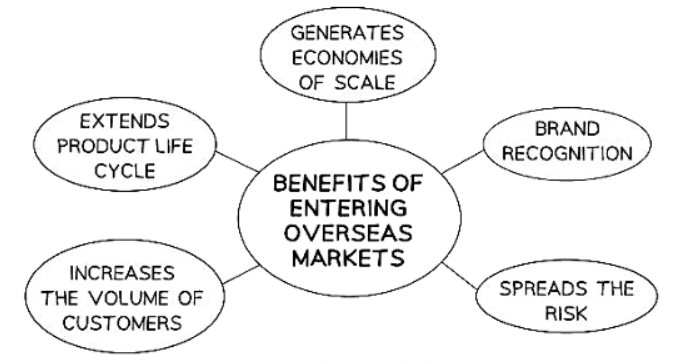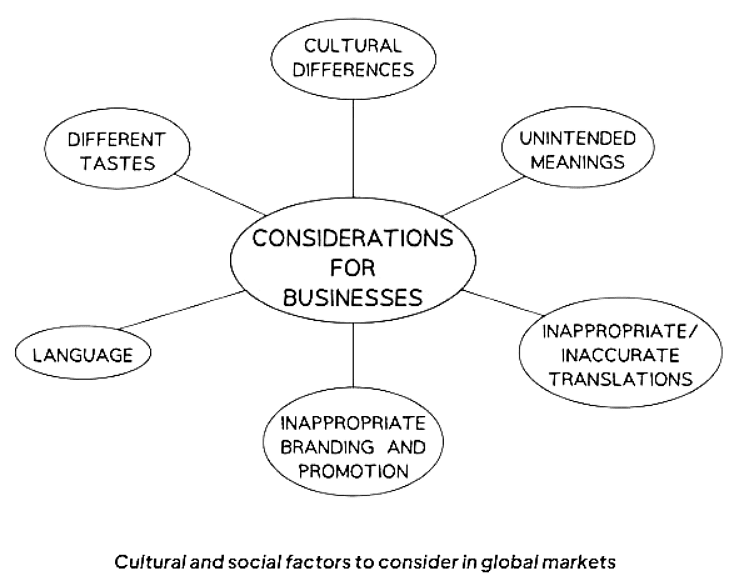Class 10 Exam > Class 10 Notes > Business Studies for GCSE/IGCSE > Entering Foreign Markets
Entering Foreign Markets | Business Studies for GCSE/IGCSE - Class 10 PDF Download
The Potential of New Markets
Many businesses find expanding into new international markets appealing:
- The internet simplifies international market entry, making it more accessible than before.
- Enhanced financial systems facilitate smoother cross-border money transactions.
- Venturing into new markets internationally becomes a logical step for businesses once they've maximized their market share for a specific product.
Benefits of Entering International Markets

- Economies of Scale:
- Operating at a larger scale can drive down per-unit costs, offering the potential for greater profit margins.
- Affords flexibility to lower prices in order to capture market share.
- Brand Recognition:
- Heightened visibility of branding, including product names and packaging.
- Particularly significant for the ethnocentric approach, fostering brand loyalty and repeat purchases.
- Risk Diversification:
- Spreads risk by lessening exposure to market fluctuations in one country.
- Helps mitigate the impact of localized economic downturns.
- Increased Customer Base:
- Opens avenues to a larger customer base, leading to higher sales revenue.
- Facilitates access to distribution efficiencies at scale.
- Extending Product Life Cycle:
- Prevents market saturation or decline in the domestic market.
- Potentially reduces the need for extensive research and development expenditure.
Problems Faced When Entering Foreign Markets
Market Knowledge Gap
- Businesses may lack understanding of customer preferences, potentially leading to producing the wrong product style or failing to meet market needs.
- For instance, Tesco faced challenges competing with local supermarkets in China due to distribution issues stemming from insufficient market knowledge.
Increased Transport Expenses
- Reliance on less dependable or costlier distribution channels can escalate transportation costs.
- Global product movement necessitates intricate logistics systems, although advancements in large-scale containerization and long-distance freight transport by rail are enhancing global distribution efficiency.
Established Competition
- Existing competitors in the market can pose obstacles to establishing market presence.
- Strong local brand loyalty may impede customer trust in foreign brands initially, requiring time to develop.
Trade Barriers
- Protectionist measures by governments aimed at shielding domestic industries from foreign competition can hinder international trade.
- Governments may impose tariffs or quotas on imports from foreign businesses, as seen in the case of cricket bats imported into the UK, subject to tariffs, potentially driving demand for locally produced brands like Kippax and Fearnley.
Exchange rate fluctuations
- Exchange rate denotes the value of one currency relative to another.
- Businesses engaged in importing raw materials and components or exporting their products are significantly impacted by exchange rates.
- Currency values can either appreciate or depreciate over time.
- Fluctuating exchange rates pose a considerable risk to businesses, making planning and forecasting challenging.
Cultural and Social factors

- Global businesses face the imperative of considering diverse cultural and social aspects to successfully market their offerings across various countries and regions.
- This adaptation can present significant challenges, particularly for smaller businesses with constrained marketing budgets, as they may:
- Lack comprehensive understanding of cultural disparities in areas like values, beliefs, customs, and traditions.
- Encounter limitations in funding extensive research on varying tastes and preferences among cultures and regions.
- Struggle to accurately and appropriately translate marketing communications.
- Overlook the potential offensive connotations of images, symbols, or language in different cultural contexts.
Question for Entering Foreign MarketsTry yourself: What is one of the potential benefits of entering international markets?View Solution
The document Entering Foreign Markets | Business Studies for GCSE/IGCSE - Class 10 is a part of the Class 10 Course Business Studies for GCSE/IGCSE.
All you need of Class 10 at this link: Class 10
|
70 videos|93 docs|26 tests
|
FAQs on Entering Foreign Markets - Business Studies for GCSE/IGCSE - Class 10
| 1. What are the potential new markets that companies can explore? |  |
Ans. Companies can explore new markets in different countries or regions where they have not yet established a presence. These markets could offer opportunities for growth and expansion.
| 2. What are some common problems that companies face when entering foreign markets? |  |
Ans. Some common problems companies face when entering foreign markets include cultural differences, language barriers, regulatory issues, and competition from local businesses.
| 3. How can companies overcome the challenges of entering foreign markets? |  |
Ans. Companies can overcome the challenges of entering foreign markets by conducting thorough market research, adapting their products or services to suit local preferences, forming strategic partnerships with local businesses, and investing in cultural awareness training for their employees.
| 4. What are the benefits of tapping into new markets for companies? |  |
Ans. Tapping into new markets can help companies diversify their revenue streams, increase their customer base, reduce dependence on a single market, and take advantage of growth opportunities in different regions.
| 5. How can companies ensure success in new markets? |  |
Ans. Companies can ensure success in new markets by developing a strong market entry strategy, building relationships with local stakeholders, continuously monitoring and adapting to market trends, and investing in marketing and advertising efforts to build brand awareness.
Related Searches




















